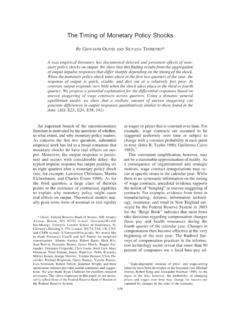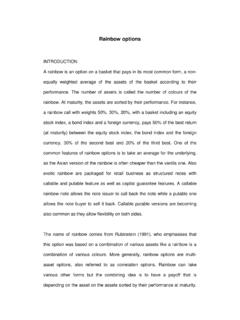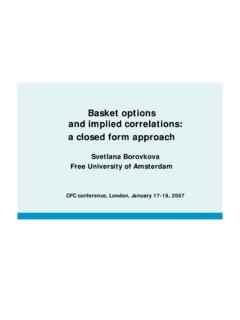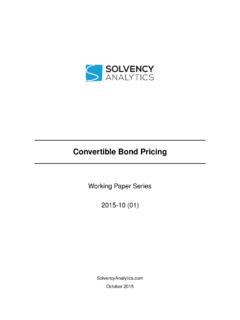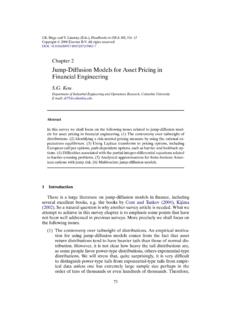Transcription of Simple Variance Swaps - LSE
1 Simple Variance Swaps Ian Martin . January, 2013. Abstract The events of 2008 9 disrupted volatility derivatives markets and caused the single-name Variance swap market to dry up completely; it has never recovered. This paper introduces the Simple Variance swap, a more robust relative of the Variance swap that can be priced and hedged even if the underlying asset's price can jump, and constructs SVIX, an index based on Simple Variance Swaps that measures market volatility . SVIX is consistently lower than VIX in the time series, which rules out the possibility that the market return and stochastic discount factor are conditionally lognormal. The SVIX index points to an equity premium that in contrast to the prevailing view in the literature is extraordinarily volatile and that spiked dramatically at the height of the recent crisis.
2 Keywords: Variance swap, VIX, equity premium, jumps, entropy.. Stanford GSB and NBER; iwrm/. First draft: November 15, 2010. I thank Torben Andersen, Andy Atkeson, Jack Busta, John Campbell, Peter Carr, Mike Chernov, John Cochrane, George Constantinides, Bernard Dumas, Darrell Duffie, Bob Hall, Stefan Hunt, Chris Jones, Stefan Nagel, Anthony Neuberger, Monika Piazzesi, Steve Ross, Myron Scholes, Costis Skiadas, Andreas Stathopoulos, Viktor Todorov; seminar par- ticipants at USC, the SITE 2011 conference, the Kellogg Finance Conference, the NBER. Summer Institute, INSEAD, LSE, and EPFL/University of Lausanne; and the Editor, As- sociate Editor, and two anonymous referees for their comments. 1. In recent years, a large market in volatility derivatives has developed. An emblem of this market, the VIX index, is often described in the financial press as the fear index ; its construction is based on theoretical results on the pricing of Variance Swaps .
3 These derivatives permit investors and dealers to hedge and to speculate in volatility itself. They also play an informational role by providing evidence about perceptions of future volatility . Unfortunately, the Variance swap market experienced turmoil as the stock market dropped sharply during the credit crisis of 2008 9. The single-name Variance swap market was particularly severely affected: it collapsed, and has not recovered. To explain why, I review the standard theory of Variance swap pricing and hedging in Section 1. The fundamental problem is that there is no known way to replicate the payoff of a Variance swap if the underlying asset's price can jump. This problem applies with particular force to individual stocks, which are more susceptible to jumps than indices are. The presence of jumps also invalidates the conventional interpretation of the VIX index, so I provide a more general interpretation.
4 In Section 2, I define and analyze the Simple Variance swap contract. Simple Variance Swaps are Simple in two senses. First, they are Simple to price and hedge: in particular, they can be hedged in the presence of jumps. Second, they measure the risk-neutral Variance of Simple returns. Simple Variance Swaps are also robust to several potential concerns regarding practical implementation. Perhaps most important, I show that my hedging and pricing results also hold, to very high accuracy, if monitoring and hedging occurs at discrete points in time, rather than continuously; this is, of course, the case that applies in practice. There is no corresponding result for Variance Swaps . Just as VIX is based on the strike of a Variance swap, one can consider an index, SVIX, that is based on the strike of a Simple Variance swap.
5 In Section 3, I construct the time series of SVIX from January 1996 to January 2012 using S&P 500 index option price data from OptionMetrics. VIX is higher than SVIX throughout the sample, and the gap between the two an index of non- lognormality spikes at times of market stress. In any conditionally lognormal model VIX would be lower than SVIX, so this is model-free evidence that we do not live in a conditionally lognormal world. Section 4 connects the SVIX index to the equity premium. I exploit an 2. identity that relates the equity premium to risk-neutral Variance and show, under a weak assumption (the negative correlation condition), that SVIX pro- vides a lower bound for the forward-looking equity premium. This lower bound has striking properties. Although it averages about 5% over the sample pe- riod, it varies dramatically, and at fairly high frequency.
6 It implies that at the height of the 2008 9 crisis, the one-month equity premium was at least (annualized), and that the one-year equity premium was at least Again, I address various issues regarding practical implementation, and show that the lower bound is conservative: it would be even higher if option prices were perfectly observable at all strikes. Related literature. The literature on Variance Swaps (Carr and Madan (1998), Demeterfi et al. (1999)) is based on papers by Breeden and Litzenberger (1978) and Neuberger (1990, 1994). Bakshi, Kapadia and Madan (2003) and Neuberger (2011) show how to use option prices to measure the higher risk- neutral moments of log returns. Lee (2010a, 2010b) provides a brief summary of volatility derivative pricing in the absence of jumps. Carr and Lee (2009). provide an excellent survey of the state of the art in the area.
7 Carr and Corso (2001) and Bondarenko (2007) have proposed different ways around the problem of hedging Variance Swaps in the presence of jumps. In both cases, the approach requires the underlying asset to be a futures contract. Bollerslev, Tauchen and Zhou (2009), Drechsler and Yaron (2011), and Bekaert and Engstrom (2011) relate Variance risk premia to equity premia in the context of specific equilibrium models. This paper provides a reason to expect that such results should hold more generally. Notation. The current date is time 0, and the terminal time horizon is T . Throughout the paper, expectations, variances, and so on, are conditional on current information. Asterisks indicate expectations and variances calculated with respect to the risk-neutral measure. There is an underlying asset whose spot price at time t is St and whose forward price to time t which is known at time 0 is F0,t.
8 The time-0 price of a European call option on the underlying asset, expiring at time t, with strike K, is call0,t (K), and the price of the corresponding put option is put0,t (K). Assumptions. I assume throughout the paper that there is no arbitrage, that there are no transaction costs or short sales constraints, and that there 3. Assumption VS VIX SVS SVIX. A1 Arbitrary strikes . A2 No dividends . A3 Constant interest rate . A4 Continuous trading . A5 No jumps . Table 1: A bullet point ( ) indicates that an assumption is required for results on Variance Swaps (VS), Simple Variance Swaps (SVS), VIX, or SVIX. A hollow bullet point ( ) indicates that an assumption can be partially relaxed. is no counterparty default. Table 1 summarizes other assumptions required in various sections of the paper. A1 European puts and calls on the underlying asset can be traded with expiry date T and arbitrary strikes.
9 A2 The underlying asset does not pay dividends. A3 The continuously-compounded interest rate is constant, at r. A4 The underlying asset and the bond can be traded continuously in time. A5 The underlying asset's price follows an It o process dSt = rSt dt+ t St dZt under the risk-neutral measure. All five assumptions are required to price and hedge Variance Swaps . As- sumption A5 can be dropped entirely for Simple Variance Swaps , which can be priced and hedged in the presence of jumps, and A1, A2 and A4 can be relaxed. Results 2 and 4 on the VIX and SVIX indexes only require A1 A2. Subsequent results are subject to assumptions discussed further below. 4. 1 Variance Swaps A Variance swap is an agreement to exchange 2 2 2. S S2 ST. log + log + + log (1). S0 S ST . for some fixed strike Ve at time T . The market convention is to set Ve so that no money needs to change hands at initiation of the trade: " 2 2 2 #.
10 S S2 S T. Ve = E log + log + + log . (2). S0 S ST . The following result, which is due to Carr and Madan (1998) and Demeterfi, Derman, Kamal, and Zou (1999), building on an idea of Neuberger (1994), shows how to price a Variance swap in the 0 limit that is, how to compute the expectation on the right-hand side of (2). From now on, Ve will always refer to the Variance swap strike in this limiting case. Result 1 (Pricing and hedging a Variance swap in the 0 limit). Under Assumptions A1 A5, the strike on a Variance swap is (Z Z ). F0,T. 1 1. Ve = 2erT put0,T (K) dK + call0,T (K) dK , (3). 0 K2 F0,T K. 2. which has the interpretation Z T .. Ve = E t2 dt . (4). 0. The Variance swap can be hedged by holding (i) a static position in (2/K 2 ) dK puts expiring at time T with strike K, for each K F0,T , (ii) a static position in (2/K 2 ) dK calls expiring at time T with strike K, for each K F0,T , and (iii) a dynamic position in 2(F0,t /St 1)/F0,T units of the underlying asset at time t, 5.



